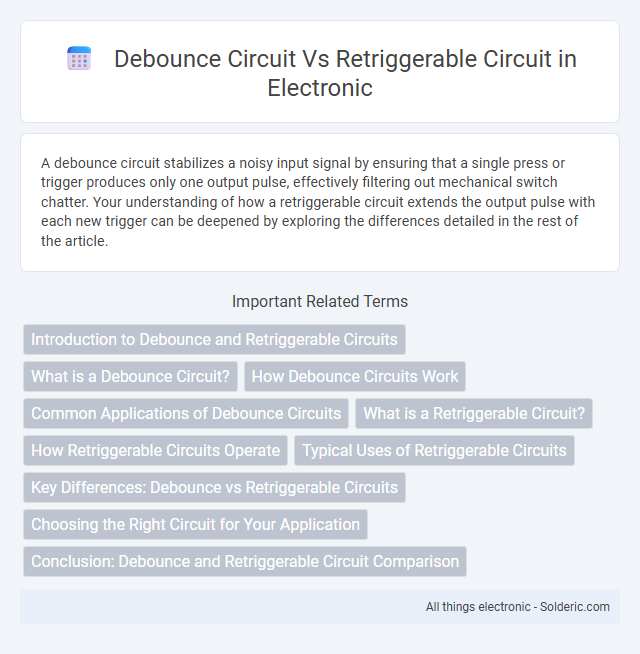A debounce circuit stabilizes a noisy input signal by ensuring that a single press or trigger produces only one output pulse, effectively filtering out mechanical switch chatter. Your understanding of how a retriggerable circuit extends the output pulse with each new trigger can be deepened by exploring the differences detailed in the rest of the article.
Comparison Table
| Feature | Debounce Circuit | Retriggerable Circuit |
|---|---|---|
| Purpose | Eliminates switch bounce noise | Extends pulse duration with repeated triggering |
| Operation | Filters mechanical contact oscillations | Resets timing window on each input pulse |
| Typical Use | Mechanical switch input stabilization | Pulse stretching, timer delay extension |
| Output Signal | Single clean pulse after switch actuation | Prolonged pulse duration while inputs continue |
| Timing Behavior | Fixed delay to ignore rapid transitions | Timing restarts on every new input pulse |
| Common Components | RC filter, Schmitt trigger IC | Retriggerable monostable multivibrator IC (e.g., 74HC123) |
| Example IC | 74HC14 Schmitt Trigger Inverter | 74HC123 Retriggerable Monostable |
| Advantages | Reliable switch input cleaning | Flexible pulse timing, easy retriggering |
| Limitations | Fixed delay may not suit all situations | Can lead to undesired long pulse if excessively triggered |
Introduction to Debounce and Retriggerable Circuits
Debounce circuits eliminate noise-induced false triggering from mechanical switches by ensuring a stable output signal after a button press, typically using RC networks or Schmitt triggers. Retriggerable circuits, often implemented with monostable multivibrators (one-shots), extend output pulse duration when triggered repeatedly within a set timeframe, maintaining the output as long as new inputs arrive before timeout. Understanding debounce circuits helps prevent erratic signals in digital systems, while retriggerable circuits manage pulse timing in applications like timers and pulse stretching.
What is a Debounce Circuit?
A debounce circuit is designed to eliminate the noise or unwanted oscillations caused by mechanical switches or buttons when they are pressed or released, ensuring a clean and stable digital signal. It stabilizes the output by filtering out rapid fluctuations that occur during the contact bounce phase, preventing false triggering in digital systems. You can rely on a debounce circuit to improve the accuracy and reliability of inputs in microcontroller or digital logic applications.
How Debounce Circuits Work
Debounce circuits work by stabilizing noisy input signals, typically from mechanical switches, to produce a clean, single transition output. They use techniques such as RC (resistor-capacitor) filtering or digital logic with timers to ignore rapid on-off fluctuations caused by contact bounce. Your circuit benefits from this reliable signal conditioning, ensuring that each button press is accurately registered without false triggers.
Common Applications of Debounce Circuits
Debounce circuits are commonly used in digital systems to eliminate noise and false triggering caused by mechanical switch contacts, ensuring clean and stable input signals for microcontrollers and digital logic. Typical applications include push-button switches, keyboard inputs, and relay control circuits where accurate signal readings are crucial. Your designs benefit from debounce circuits by preventing multiple unwanted pulses, enhancing the reliability and performance of user interfaces and control systems.
What is a Retriggerable Circuit?
A retriggerable circuit is a timing circuit that resets its timing interval whenever it receives an input pulse before the current timing cycle ends, ensuring continuous output for overlapping signals. Commonly used in monostable multivibrator applications, retriggerable circuits extend the output pulse duration based on successive triggers, unlike debounce circuits that primarily filter noise from mechanical switches. This functionality is essential in digital systems requiring stable, noise-free pulse generation without unintended shortening of the output signal.
How Retriggerable Circuits Operate
Retriggerable circuits operate by extending the output pulse duration each time a new input trigger is received before the previous pulse ends, ensuring a continuous output signal during repetitive triggers. Unlike debounce circuits that simply filter out noise or unwanted fluctuations from mechanical switches, retriggerable circuits maintain activation as long as inputs persist within the timing interval. Your applications requiring precise timing control benefit from retriggerable designs by preventing premature output cessation during ongoing input signals.
Typical Uses of Retriggerable Circuits
Retriggerable circuits are commonly used in timing applications where pulse extension or reset is necessary, such as in monostable multivibrators for pulse width modulation and delay timers. They excel in environments requiring continuous pulse generation without output reset, ideal for debounce circuits in mechanical switches and signal conditioning in digital communication. These circuits ensure stable output signals by preventing premature termination, which enhances noise immunity and timing accuracy.
Key Differences: Debounce vs Retriggerable Circuits
Debounce circuits stabilize noisy signals from mechanical switches by filtering out rapid on/off pulses, ensuring a clean single output transition. Retriggerable circuits, often used in timers and pulse shaping, extend output pulses if new input signals arrive before the current pulse ends, maintaining a continuous output as long as triggers persist. Understanding these key differences helps you choose the right circuit for applications requiring signal stabilization versus pulse duration control.
Choosing the Right Circuit for Your Application
Debounce circuits are ideal for eliminating noise and false triggering caused by mechanical switch contacts, making them perfect for simple input signal stabilization in digital systems. Retriggerable circuits excel in timing applications requiring pulse extension or resettable delay intervals, ensuring output pulse duration restarts with each input trigger. Selecting the right circuit depends on whether your application demands signal cleaning for stable transitions or flexible pulse timing control for dynamic input conditions.
Conclusion: Debounce and Retriggerable Circuit Comparison
Debounce circuits stabilize input signals by filtering out noise caused by mechanical switch bounces, ensuring a single clean pulse from a single press. Retriggerable circuits extend the output pulse duration if the input pulse recurs within a specified time, useful for maintaining a continuous output as long as repeated triggers occur. Debounce circuits prioritize signal clarity and noise immunity, while retriggerable circuits emphasize pulse width control and responsiveness to repeated input events.
debounce circuit vs retriggerable circuit Infographic

 solderic.com
solderic.com